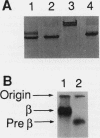Abstract
Lipoprotein(a) [Lp(a)] is an atherogenic lipoprotein which is similar in structure to low density lipoproteins (LDL). The role of the LDL receptor in the catabolism of Lp(a) has been controversial. We therefore investigated the in vivo catabolism of Lp(a) and LDL in five unrelated patients with homozygous familial hypercholesterolemia (FH) who have little or no LDL receptor activity. Purified 125I-Lp(a) and 131I-LDL were simultaneously injected into the homozygous FH patients, their heterozygous FH parents when available, and control subjects. The disappearance of plasma radioactivity was followed over time. As expected, the fractional catabolic rates (FCR) of 131I-LDL were markedly decreased in the homozygous FH patients (mean LDL FCR 0.190 d-1) and somewhat decreased in the heterozygous FH parents (mean LDL FCR 0.294 d-1) compared with controls (mean LDL FCR 0.401 d-1). In contrast, the catabolism of 125I-Lp(a) was not significantly different in the homozygous FH patients (mean FCR 0.251 d-1), heterozygous FH parents (mean FCR 0.254 d-1), and control subjects (mean FCR 0.287 d-1). In summary, absence of a functional LDL receptor does not result in delayed catabolism of Lp(a), indicating that the LDL receptor is not a physiologically important route of Lp(a) catabolism in humans.
Full text
PDF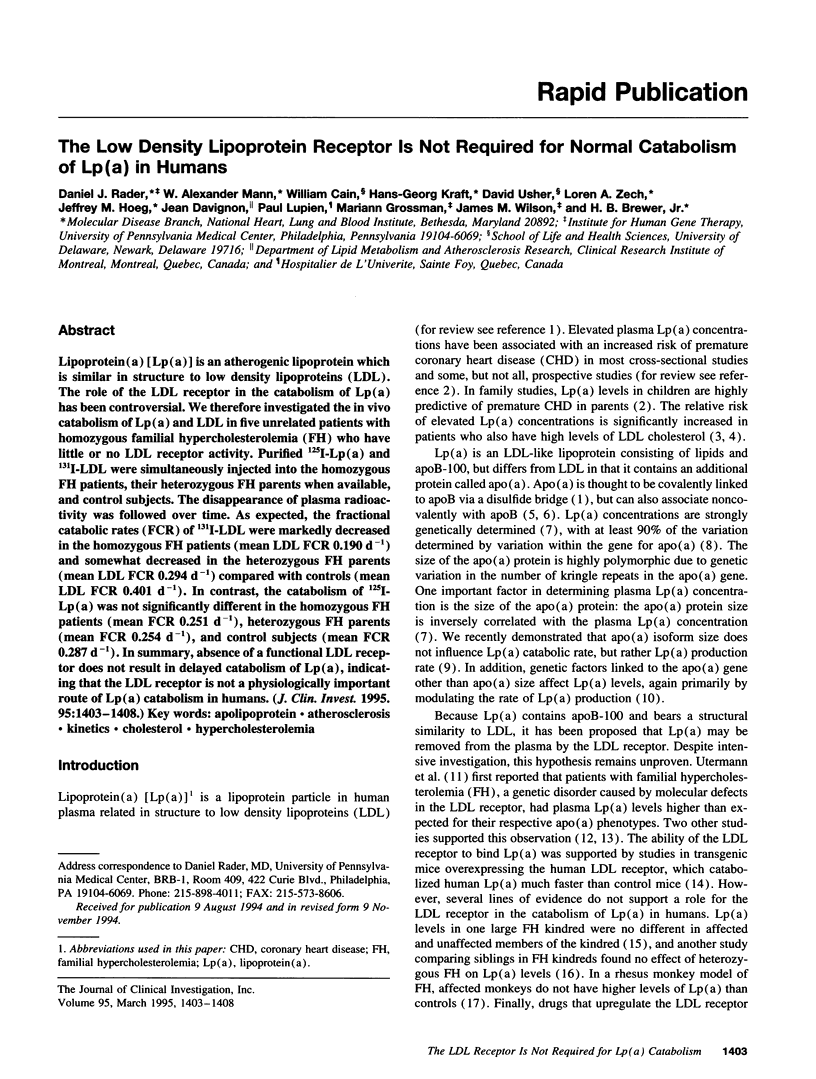
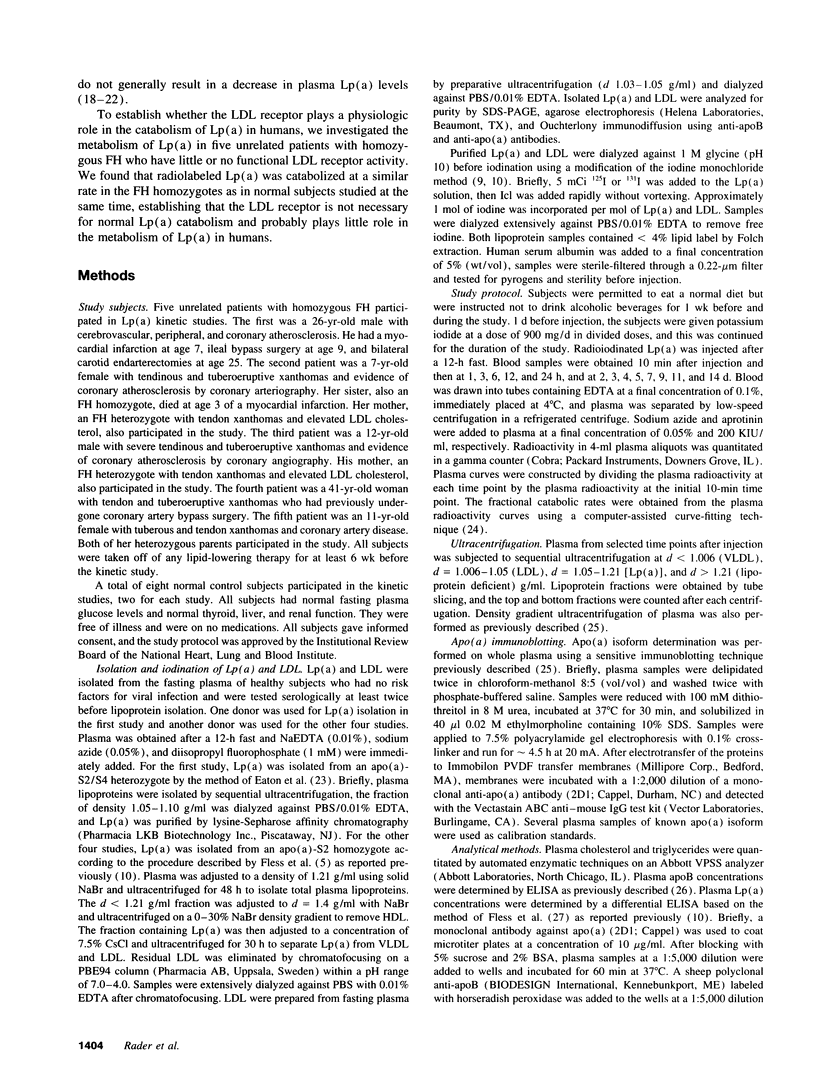
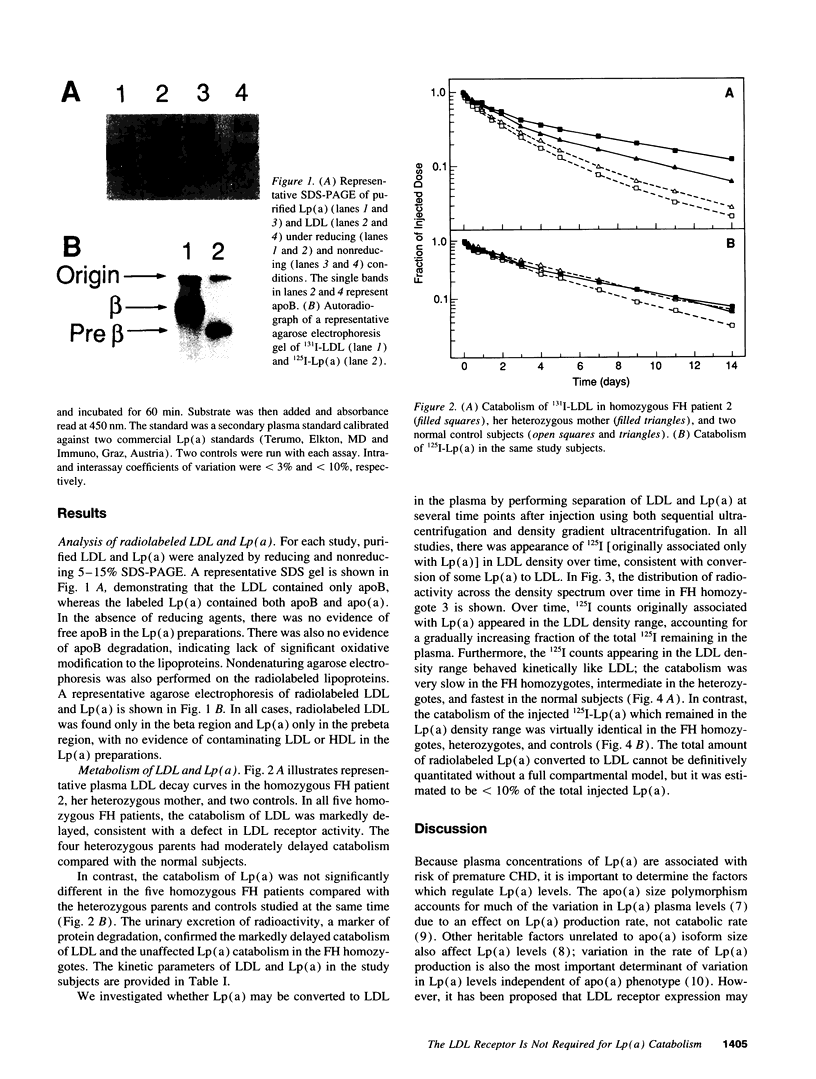


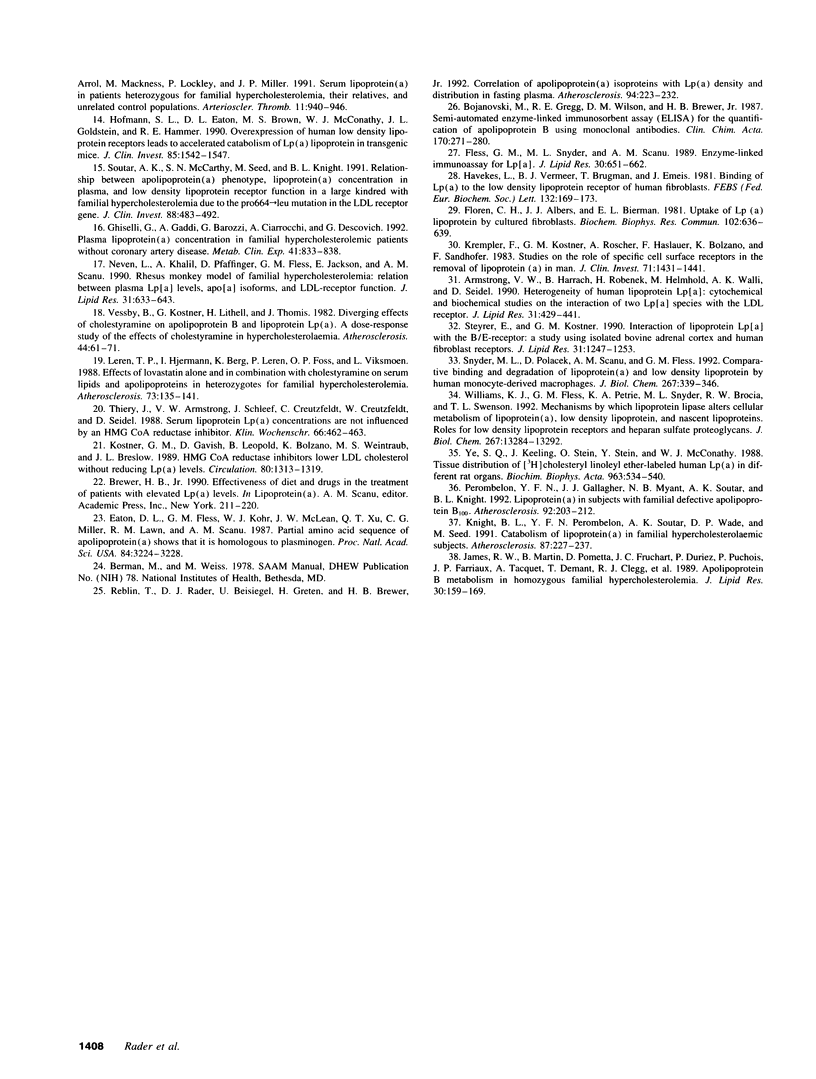
Images in this article
Selected References
These references are in PubMed. This may not be the complete list of references from this article.
- Armstrong V. W., Cremer P., Eberle E., Manke A., Schulze F., Wieland H., Kreuzer H., Seidel D. The association between serum Lp(a) concentrations and angiographically assessed coronary atherosclerosis. Dependence on serum LDL levels. Atherosclerosis. 1986 Dec;62(3):249–257. doi: 10.1016/0021-9150(86)90099-7. [DOI] [PubMed] [Google Scholar]
- Armstrong V. W., Harrach B., Robenek H., Helmhold M., Walli A. K., Seidel D. Heterogeneity of human lipoprotein Lp[a]: cytochemical and biochemical studies on the interaction of two Lp[a] species with the LDL receptor. J Lipid Res. 1990 Mar;31(3):429–441. [PubMed] [Google Scholar]
- Boerwinkle E., Leffert C. C., Lin J., Lackner C., Chiesa G., Hobbs H. H. Apolipoprotein(a) gene accounts for greater than 90% of the variation in plasma lipoprotein(a) concentrations. J Clin Invest. 1992 Jul;90(1):52–60. doi: 10.1172/JCI115855. [DOI] [PMC free article] [PubMed] [Google Scholar]
- Bojanovski M., Gregg R. E., Wilson D. M., Brewer H. B., Jr Semi-automated enzyme-linked immunosorbent assay (ELISA) for the quantification of apolipoprotein B using monoclonal antibodies. Clin Chim Acta. 1987 Dec;170(2-3):271–280. doi: 10.1016/0009-8981(87)90137-9. [DOI] [PubMed] [Google Scholar]
- Eaton D. L., Fless G. M., Kohr W. J., McLean J. W., Xu Q. T., Miller C. G., Lawn R. M., Scanu A. M. Partial amino acid sequence of apolipoprotein(a) shows that it is homologous to plasminogen. Proc Natl Acad Sci U S A. 1987 May;84(10):3224–3228. doi: 10.1073/pnas.84.10.3224. [DOI] [PMC free article] [PubMed] [Google Scholar]
- Fless G. M., Snyder M. L., Scanu A. M. Enzyme-linked immunoassay for Lp[a]. J Lipid Res. 1989 May;30(5):651–662. [PubMed] [Google Scholar]
- Fless G. M., ZumMallen M. E., Scanu A. M. Isolation of apolipoprotein(a) from lipoprotein(a). J Lipid Res. 1985 Oct;26(10):1224–1229. [PubMed] [Google Scholar]
- Floren C. H., Albers J. J., Bierman E. L. Uptake of Lp (a) lipoprotein by cultured fibroblasts. Biochem Biophys Res Commun. 1981 Sep 30;102(2):636–639. doi: 10.1016/s0006-291x(81)80179-9. [DOI] [PubMed] [Google Scholar]
- Ghiselli G., Gaddi A., Barozzi G., Ciarrocchi A., Descovich G. Plasma lipoprotein(a) concentration in familial hypercholesterolemic patients without coronary artery disease. Metabolism. 1992 Aug;41(8):833–838. doi: 10.1016/0026-0495(92)90163-5. [DOI] [PubMed] [Google Scholar]
- Havekes L., Vermeer B. J., Brugman T., Emeis J. Binding of LP(a) to the low density lipoprotein receptor of human fibroblasts. FEBS Lett. 1981 Sep 28;132(2):169–173. doi: 10.1016/0014-5793(81)81153-2. [DOI] [PubMed] [Google Scholar]
- Hofmann S. L., Eaton D. L., Brown M. S., McConathy W. J., Goldstein J. L., Hammer R. E. Overexpression of human low density lipoprotein receptors leads to accelerated catabolism of Lp(a) lipoprotein in transgenic mice. J Clin Invest. 1990 May;85(5):1542–1547. doi: 10.1172/JCI114602. [DOI] [PMC free article] [PubMed] [Google Scholar]
- James R. W., Martin B., Pometta D., Fruchart J. C., Duriez P., Puchois P., Farriaux J. P., Tacquet A., Demant T., Clegg R. J. Apolipoprotein B metabolism in homozygous familial hypercholesterolemia. J Lipid Res. 1989 Feb;30(2):159–169. [PubMed] [Google Scholar]
- Knight B. L., Perombelon Y. F., Soutar A. K., Wade D. P., Seed M. Catabolism of lipoprotein(a) in familial hypercholesterolaemic subjects. Atherosclerosis. 1991 Apr;87(2-3):227–237. doi: 10.1016/0021-9150(91)90025-x. [DOI] [PubMed] [Google Scholar]
- Kostner G. M., Gavish D., Leopold B., Bolzano K., Weintraub M. S., Breslow J. L. HMG CoA reductase inhibitors lower LDL cholesterol without reducing Lp(a) levels. Circulation. 1989 Nov;80(5):1313–1319. doi: 10.1161/01.cir.80.5.1313. [DOI] [PubMed] [Google Scholar]
- Krempler F., Kostner G. M., Roscher A., Haslauer F., Bolzano K., Sandhofer F. Studies on the role of specific cell surface receptors in the removal of lipoprotein (a) in man. J Clin Invest. 1983 May;71(5):1431–1441. doi: 10.1172/JCI110896. [DOI] [PMC free article] [PubMed] [Google Scholar]
- Leren T. P., Hjermann I., Berg K., Leren P., Foss O. P., Viksmoen L. Effects of lovastatin alone and in combination with cholestyramine on serum lipids and apolipoproteins in heterozygotes for familial hypercholesterolemia. Atherosclerosis. 1988 Oct;73(2-3):135–141. doi: 10.1016/0021-9150(88)90034-2. [DOI] [PubMed] [Google Scholar]
- Mbewu A. D., Bhatnagar D., Durrington P. N., Hunt L., Ishola M., Arrol S., Mackness M., Lockley P., Miller J. P. Serum lipoprotein(a) in patients heterozygous for familial hypercholesterolemia, their relatives, and unrelated control populations. Arterioscler Thromb. 1991 Jul-Aug;11(4):940–946. doi: 10.1161/01.atv.11.4.940. [DOI] [PubMed] [Google Scholar]
- Neven L., Khalil A., Pfaffinger D., Fless G. M., Jackson E., Scanu A. M. Rhesus monkey model of familial hypercholesterolemia: relation between plasma Lp[a] levels, apo[a] isoforms, and LDL-receptor function. J Lipid Res. 1990 Apr;31(4):633–643. [PubMed] [Google Scholar]
- Perombelon Y. F., Gallagher J. J., Myant N. B., Soutar A. K., Knight B. L. Lipoprotein(a) in subjects with familial defective apolipoprotein B100. Atherosclerosis. 1992 Feb;92(2-3):203–212. doi: 10.1016/0021-9150(92)90279-p. [DOI] [PubMed] [Google Scholar]
- Rader D. J., Cain W., Ikewaki K., Talley G., Zech L. A., Usher D., Brewer H. B., Jr The inverse association of plasma lipoprotein(a) concentrations with apolipoprotein(a) isoform size is not due to differences in Lp(a) catabolism but to differences in production rate. J Clin Invest. 1994 Jun;93(6):2758–2763. doi: 10.1172/JCI117292. [DOI] [PMC free article] [PubMed] [Google Scholar]
- Rader D. J., Cain W., Zech L. A., Usher D., Brewer H. B., Jr Variation in lipoprotein(a) concentrations among individuals with the same apolipoprotein (a) isoform is determined by the rate of lipoprotein(a) production. J Clin Invest. 1993 Feb;91(2):443–447. doi: 10.1172/JCI116221. [DOI] [PMC free article] [PubMed] [Google Scholar]
- Rader D. J., Hoeg J. M., Brewer H. B., Jr Quantitation of plasma apolipoproteins in the primary and secondary prevention of coronary artery disease. Ann Intern Med. 1994 Jun 15;120(12):1012–1025. doi: 10.7326/0003-4819-120-12-199406150-00008. [DOI] [PubMed] [Google Scholar]
- Reblin T., Rader D. J., Beisiegel U., Greten H., Brewer H. B., Jr Correlation of apolipoprotein(a) isoproteins with Lp(a) density and distribution in fasting plasma. Atherosclerosis. 1992 Jun;94(2-3):223–232. doi: 10.1016/0021-9150(92)90247-e. [DOI] [PubMed] [Google Scholar]
- Scanu A. M., Fless G. M. Lipoprotein (a). Heterogeneity and biological relevance. J Clin Invest. 1990 Jun;85(6):1709–1715. doi: 10.1172/JCI114625. [DOI] [PMC free article] [PubMed] [Google Scholar]
- Seed M., Hoppichler F., Reaveley D., McCarthy S., Thompson G. R., Boerwinkle E., Utermann G. Relation of serum lipoprotein(a) concentration and apolipoprotein(a) phenotype to coronary heart disease in patients with familial hypercholesterolemia. N Engl J Med. 1990 May 24;322(21):1494–1499. doi: 10.1056/NEJM199005243222104. [DOI] [PubMed] [Google Scholar]
- Snyder M. L., Polacek D., Scanu A. M., Fless G. M. Comparative binding and degradation of lipoprotein(a) and low density lipoprotein by human monocyte-derived macrophages. J Biol Chem. 1992 Jan 5;267(1):339–346. [PubMed] [Google Scholar]
- Soutar A. K., McCarthy S. N., Seed M., Knight B. L. Relationship between apolipoprotein(a) phenotype, lipoprotein(a) concentration in plasma, and low density lipoprotein receptor function in a large kindred with familial hypercholesterolemia due to the pro664----leu mutation in the LDL receptor gene. J Clin Invest. 1991 Aug;88(2):483–492. doi: 10.1172/JCI115329. [DOI] [PMC free article] [PubMed] [Google Scholar]
- Steyrer E., Kostner G. M. Interaction of lipoprotein Lp[a] with the B/E-receptor: a study using isolated bovine adrenal cortex and human fibroblast receptors. J Lipid Res. 1990 Jul;31(7):1247–1253. [PubMed] [Google Scholar]
- Thiery J., Armstrong V. W., Schleef J., Creutzfeldt C., Creutzfeldt W., Seidel D. Serum lipoprotein Lp(a) concentrations are not influenced by an HMG CoA reductase inhibitor. Klin Wochenschr. 1988 May 16;66(10):462–463. doi: 10.1007/BF01745519. [DOI] [PubMed] [Google Scholar]
- Trieu V. N., Zioncheck T. F., Lawn R. M., McConathy W. J. Interaction of apolipoprotein(a) with apolipoprotein B-containing lipoproteins. J Biol Chem. 1991 Mar 25;266(9):5480–5485. [PubMed] [Google Scholar]
- Utermann G., Hoppichler F., Dieplinger H., Seed M., Thompson G., Boerwinkle E. Defects in the low density lipoprotein receptor gene affect lipoprotein (a) levels: multiplicative interaction of two gene loci associated with premature atherosclerosis. Proc Natl Acad Sci U S A. 1989 Jun;86(11):4171–4174. doi: 10.1073/pnas.86.11.4171. [DOI] [PMC free article] [PubMed] [Google Scholar]
- Utermann G., Menzel H. J., Kraft H. G., Duba H. C., Kemmler H. G., Seitz C. Lp(a) glycoprotein phenotypes. Inheritance and relation to Lp(a)-lipoprotein concentrations in plasma. J Clin Invest. 1987 Aug;80(2):458–465. doi: 10.1172/JCI113093. [DOI] [PMC free article] [PubMed] [Google Scholar]
- Vessby B., Kostner G., Lithell H., Thomis J. Diverging effects of cholestyramine on apolipoprotein B and lipoprotein Lp(a). A dose-response study of the effects of cholestyramine in hypercholesterolaemia. Atherosclerosis. 1982 Jul;44(1):61–71. doi: 10.1016/0021-9150(82)90053-3. [DOI] [PubMed] [Google Scholar]
- Wiklund O., Angelin B., Olofsson S. O., Eriksson M., Fager G., Berglund L., Bondjers G. Apolipoprotein(a) and ischaemic heart disease in familial hypercholesterolaemia. Lancet. 1990 Jun 9;335(8702):1360–1363. doi: 10.1016/0140-6736(90)91242-3. [DOI] [PubMed] [Google Scholar]
- Williams K. J., Fless G. M., Petrie K. A., Snyder M. L., Brocia R. W., Swenson T. L. Mechanisms by which lipoprotein lipase alters cellular metabolism of lipoprotein(a), low density lipoprotein, and nascent lipoproteins. Roles for low density lipoprotein receptors and heparan sulfate proteoglycans. J Biol Chem. 1992 Jul 5;267(19):13284–13292. [PubMed] [Google Scholar]
- Ye S. Q., Keeling J., Stein O., Stein Y., McConathy W. J. Tissue distribution of [3H]cholesteryl linoleyl ether-labeled human Lp(a) in different rat organs. Biochim Biophys Acta. 1988 Dec 16;963(3):534–540. doi: 10.1016/0005-2760(88)90322-0. [DOI] [PubMed] [Google Scholar]



